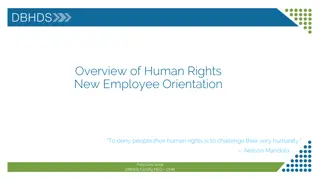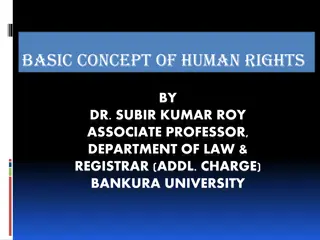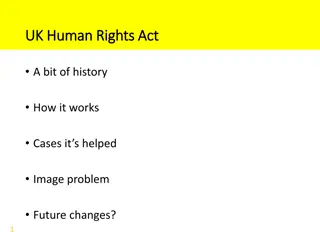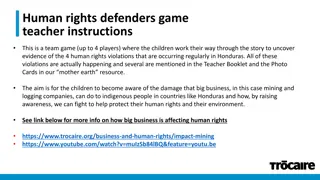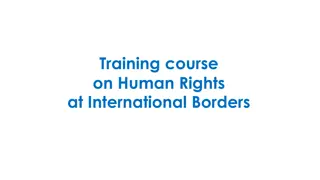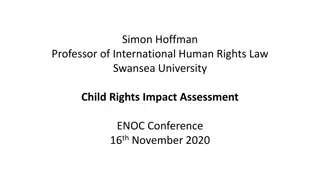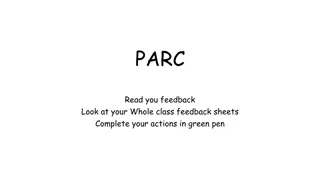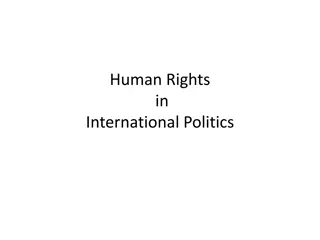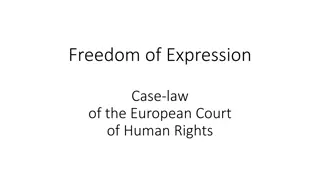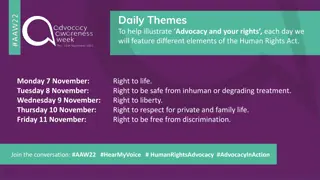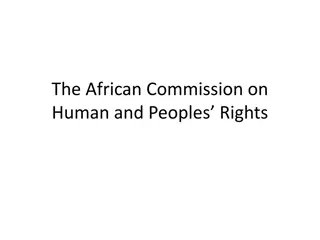KORLOY's Human Rights Initiatives and Impact Assessment 2023
KORLOY, in response to its commitment to ethical management, upholds human rights principles endorsed by the UN. Its anti-discrimination policy ensures equal employment opportunities. The company performs human rights impact assessments, prioritizing improvement tasks. Continuous monitoring and internal promotions facilitate a culture of respect and inclusivity.
Download Presentation

Please find below an Image/Link to download the presentation.
The content on the website is provided AS IS for your information and personal use only. It may not be sold, licensed, or shared on other websites without obtaining consent from the author. Download presentation by click this link. If you encounter any issues during the download, it is possible that the publisher has removed the file from their server.
E N D
Presentation Transcript
ESG Announced document (Human Rights) 2023.04.20
Table of Contents Members/ Rights Human rights policy 02 Anti-discrimination and harassment policy 02 Human rights impact assessment 02 Mandatory legal education 03 Status of labor union membership 03 Employee grievance handling 03 Grievance handling system 04 Member diversity and inclusiveness Total number and percentage of male and female workers 05 Proportion of female workers among all workers 05 Parental and maternity leave 05 Gender pay gap 06 Employment status of people with disabilities 06 Status of regular and non-regular employment 06 Members/ Human capital Recruitment 07 Turnover rate 07 Average length of employment 07 Welfare system 07 Employee welfare benefits 07 Educational programs 08 Status of participants in education programs 08 Education and training support cost per employee 08 Education and training time per employee 08 Performance evaluation 08
Members/ Rights Human rights policy In 2022, KORLOY established a new organizational culture called "New Design" to redefine its core values and build a new culture that emphasizes communication and collaboration, recognizing and respecting differences. As a global company, KORLOY always aims to be a model of ethical management and supports and practices the human rights principles promoted by the "UN Universal Declaration of Human Rights" and the "UN Guiding Principles on Business and Human Rights" advocated by the UN Human Rights Commission. Anti-discrimination and harassment policy KORLOY 's employment rules in Chapter 2, Recruitment of Employees, state that it does not discriminate based on gender, age, religion, social status, place of origin, alma mater, marriage, pregnancy, age, childbirth, or medical history without a reasonable justification. The company also incorporates the contents of Chapter 5, Protection of Motherhood and Family Conciliation, Chapter 8, Education and Prevention of Sexual Harassment, and Chapter 9, Prevention of Workplace Bullying. This policy is managed and operated through the Integrated Personnel Committee and labor-management agreements. If revisions are necessary, the revised content is announced and promoted internally. Human rights impact assessment According to the results of the Ministry of Employment and Labor's inspection for labor supervision and self- improvement of working conditions from 2015 to 2023, no serious human rights violations have been discovered in domestic workplaces, and measures have been taken to improve issues requiring attention, such as partial deficiencies and subcontracting. Meanwhile, the company established priority improvement tasks and long-term improvement goals for each item requiring improvement in organizational culture and personnel system. We also plan to continuously monitor whether improvements are being made. Section Contents Year (times) Remarks 2022(once) 2021(once) 2020(once) 2018(2 times) 2017(once) Employment contract, payroll book and attendance records, employment regulations, regulations and meeting minutes of labor-management council, record of sexual harassment prevention education and etc. Headquarters, factory, branch office Self-improvement of working conditions Representative themes of organizational culture: 64 questions rated on a 7-point scale (structure, culture, performance, duties, talent, strategy, organizational culture, and environment) No Open, No Change (communication/collaboration/empathy/freedom) All Organizational culture interview/survey/Open-i 2022(3 time) employees/clients, companies 25 multiple-choice questions rated on a 6-point scale and 2 open-ended questions (overall personnel system, evaluation, rank, position, promotion, compensation) Job classification system (management/general positions, by series/job type) Personnel system interview/survey/Job Analysis 2022(3 time) All employees 02
Members/ Rights Legal Compliance Training Record Legal compliance training No. of participants completed the training Prevention of sexual harassment in the workplace Target audience Personal information protection Improving awareness of disabilities in the workplace Section Retirement pension 2013 545 - 2014 581 - Internal training (Collective) Internal training (Collective) 2015 610 - 2016 613 - Written Education (posting) 2017 629 - All 2018 679 employees External training (Collective) 2019 685 External training (Collective) 2020 682 Internal training (Collective) Internal training (Collective) Internal training (Collective) 2021 662 2022 690 2023 716 Planned for the second half of the year May in 2018-Required education Training hours Section Contents Prevention of sexual harassment in the 1) Sexual Harassment in the Workplace 2) Criteria for Determining Workplace Sexual Harassment 3) Response and Precautions for Sexual Harassment Perpetrators in the Workplace 4) Guidelines for Preventing Sexual Harassment in the Workplace 5)Penalties for Violating Sexual Harassment Policies 1Hr Personal information protection 1) Importance of Security 2) Personal Security Items 3) Ransomware 4) Voice Phishing 5) Prohibition of Illegal Software Use 6) 10 Practical Rules 7) Code of Conduct for Industrial Security 8) Understanding Relevant Laws and Regulations 1Hr 1) Types of Disabilities in Korea 2) Rights of Disabled Persons in the Workplace and Prohibition of Discrimination against the Disabled and Provision of Reasonable Accommodations 3) Laws and Systems Related to Promoting Employment of Disabled Individuals and Vocational Rehabilitation 4) Development of Professional Fields for the Disabled and Model Cases of Employment 5) Obligation to Conduct Education to Improve Awareness of Disabilities in the Workplace Improving awareness of disabilities in the workplace 1Hr 1) Importance of Retirement Planning 2) Characteristics of Different Types of Retirement Pension Systems 3) Payment Procedures at Retirement and Before the Introduction of IRP 4) Guide to Taxation Systems 5) Preconditions and Procedures for Partial Withdrawal Retirement pension 1Hr Status of labor union membership No. of union member (Admission rate %) Section Unit 2018 2019 2020 2021 2022 2023.03 Union presence Existence(one) 283 (42%) 295 (43%) 295 (43%) 296 (45%) 294 (43%) 307 (43%) Existence of superior organization Existence Korean Confederation of Trade Unions Name of federation of labor unions Employee grievance handling 2018 2019 2020 2021 2022 2023.03 Section Unit - - - - - - Sexual harassment in the workplace - - - - - - Maternal protection/ Discrimination No. of receipt - - - - 2 - Workplace harassment 03
Members/ Rights Grievance handling system KORLOY specifies the operation of the grievance handling system in accordance with the employment regulations. (Article 91, Handling of Complaints - The Company operates an internal complaints handling system in accordance with relevant laws and strives for autonomous resolution of complaints from workers.) Measures to prevent sexual harassment at KORLOY Section Contents Conduct sexual harassment prevention education at least once a year. Develop internal sexual harassment prevention guidelines (education, promotional materials distribution). Prevention education Article 59, Chapter 6 of the Employment Regulations for the Prevention of Sexual Harassment: 1. To create a safe working environment in which employees can work safely, the company shall conduct sexual harassment prevention education at least once a year, covering the main points of sexual harassment-related laws and regulations, the employer's policy on preventing sexual harassment, the management and redress of sexual harassment victims, and the measures to be taken against perpetrators. 2. All executives and employees of the company shall not engage in any act that constitutes sexual harassment prohibited by the Gender Equality Employment Act. 3. In the case of an employee who engages in sexual harassment in the workplace and causes a conflict, disciplinary action, including dismissal, may be taken, and the employee will be relocated to a different position so as not to work in the same workplace as the victim of sexual harassment. Processing policy Institutionalization Establish an official channel for counseling and redressing sexual harassment. Appoint one or more sexual harassment complaints handler (one male and one female). Establish a victim redress procedure. 1. Receipt of complaint: the employee's immediate superior or the HR team. 2. Complaint counseling and investigation: conduct fair and prompt investigation while maintaining confidentiality of both parties. 3. Verification and disciplinary action: if sexual harassment is confirmed, report to management and take disciplinary action. 4. Notification of results: notify both parties of the investigation results and make efforts to prevent recurrence. Recess procedure and development of a manual Procedures for employee complaints and grievance redressal Section Contents Sexual harassment reporting Sexual harassment complaint investigation Immediate and prompt response, fair and thorough investigation including hearing explanation from both the perpetrator and victim, and maintaining detailed records. Counselling and investigation Verification of counseling and investigation If the action is not considered sexual harassment, notifying the parties involved and ending the investigation. If the action is deemed sexual harassment, taking appropriate action based on the nature and severity of the case. Verification and action Personnel action and disciplinary measures In case of the serious matter, taking disciplinary action according to disciplinary procedure Notification o results and prevention of recurrence Notification of conclusion and continuous management of perpetrators and victims Education for preventing similar incidents in the future 04
Member diversity and inclusiveness Total number and percentage of male and female workers FemaleRatio Section Unit 2018 2019 2020 2021 2022 2023.03 Total number of employees 679 685 682 662 690 716 Male 618 626 622 603 622 647 Gender 9% 9% 9% 9% 10% 10% Female 61 59 60 59 68 69 Male Person 605 604 612 587 606 620 Permanent 8% 8% 8% 8% 8% 9% Female 55 53 53 54 56 59 Type of employment Male 13 22 10 16 16 27 Temporary 32% 21% 41% 24% 43% 27% Female 6 6 7 5 12 10 Proportion of female workers among all workers Women workers make up less than 10% of the total workforce, but we're making efforts to gradually increase their numbers and improve their representation. FemaleRatio Section Unit 2018 2019 2020 2021 2022 2023.03 Total number of employees 679 685 682 662 690 716 Male Person 618 626 622 603 622 647 Permanent 9.0% 8.6% 8.8% 8.9% 9.9% 9.6% Female 61 59 60 59 68 69 Parental and maternity leave Section Unit 2018 2019 2020 Male 618 626 622 603 622 647 Recipient Female 61 59 60 59 68 69 Male 2 4 4 5 8 4 Parental leave and maternity leave usage Person Female 1 2 2 3 2 1 Male 4 4 3 8 4 Returning employee Female 1 2 2 2 2 1 Rate of returning to work after using parental leave and maternity leave 33% 100% 100% 63% 100% 100% % Rate of employment for more than 12 months after returning to work 100% 100% 100% 100% 100% 100% 05
Member diversity and inclusiveness Gender pay gap Section Unit 2018 2019 2020 2021 2022 2023.03 Average salary per person 1 million won 48.0 48.9 50.1 50.5 51.9 54.8 Base pay ratio by gender (by position and seniority) 100 100 100 100 100 100 % Permanent 100 100 100 100 100 100 Type of employment Temporary 100 100 100 100 100 100 Employment status of people with disabilities The employment rate of workers with disabilities is less than 1% of the total workforce, which falls short of the legal requirement of 3.1%. However, we're making efforts to gradually increase the number of workers with disabilities in our workforce. Section Unit 2018 2019 2020 2021 2022 2023.03 Employment rate of the disabled 2.9% 2.9% 3.1% 3.1% 3.1% 3.1% Person 3 4 4 6 6 5 Employment status of the disabled % 0.49 0.56 0.63 0.95 0.96 0.78 Status of regular and non-regular employment Section Unit 2018 2019 2020 2021 2022 2023.03 660 657 665 641 662 679 Permanent Type of employment Person 19 28 17 21 28 37 Temporary 06
Members/ Human capital Recruitment Section Unit 2018 2019 2020 2021 2022 2023.03 Total number of employees hired 82 61 30 63 102 49 With an bachelor s degree or higher Person 32 8 18 19 42 22 New hires With an associate s degree or higher 50 53 12 44 60 27 Turnover rate Section Unit 2018 2019 2020 2021 2022 2023.03 Overall turnover rate 5% 8% 8% 10% 11% 3% With an bachelor s degree or higher 2% 2% 2% 4% 3% 1% % Turnover rate With an associate s degree or higher 3% 6% 5% 6% 8% 2% Average length of employment Section Unit 2018 2019 2020 2021 2022 2023.03 Average length of service Year 12.4 12.4 12.4 13.0 13.0 13.0 Welfare system We provide the same welfare benefits to all regular and contractual employees. Section Contents Education support Operation of talent development programs for enhancing employees' competencies Social stability support Operation of housing-related loan support system and talent development programs Operation of fitness center for employees' health, comprehensive health check-up program, and 4 major insurance enrollments Employee health support Cultural life support Support for employees' club activities to enable them to have a high-quality cultural life and rest Conducting various events such as helping neighbors in need, voluntary activities outside of work, team building workshops, athletic competition, outdoor activities, birthday parties, etc. Education expenses support to minimize financial burden and ensure quality education for employees' children Social life support Scholarship support for employees children Employee welfare programs including subsidies for significant events, long-term service rewards, operation of employee cafeteria, and providing company shuttle bus for factory workers' commute Other policies Employee welfare benefits Section Unit 2018 2019 2020 2021 2022 2023.03 Total sales 2045.8 2022.9 1608.5 1833.8 2146.8 384.2 100 million won Welfare benefit 68.7 69.5 68.0 70.9 80.4 13.4 Rate % 3.4% 3.4% 4.2% 3.9% 3.7% 3.5% Employee benefit expenses per person 1 million won 10.1 10.1 9.9 10.7 11.6 1.8 07
Members/ Human capital Educational programs We offer a program for capacity development and skills improvement for all regular employees. Section Joint education Mandatory training for promotion HPC, firefighting training Education Job training Mandatory legal education Technical education Status of participants in education programs Number of actual participants Section Number of target people Ratio Distance learning education 27 27 100% Joint education 421 421 100% Education External training 3 3 100% Online education 134 134 100% Mandatory legal education 690 690 100% Total amount 1275 1275 100% Education and training support cost per employee Section Unit 2018 2019 2020 2021 2022 2023.03 Number of actual participants in education Person 748 777 402 491 585 164 Total training cost 111 140.2 80.2 77.5 106.9 50.5 1 million won Training cost per person 0.15 0.18 0.20 0.16 0.18 0.31 Education and training time per employee Section Unit 2018 2019 2020 2021 2022 2023.03 Number of actual participants in education Person 748 777 402 491 585 164 Total training time 11550 13536 12873 13649 7473 1445.5 Time Training cost per person 15.0 17.4 32.0 27.8 13.0 8.8 Performance evaluation Section Unit 2018 2019 2020 2021 2022 2023.03 Number of employees subject to performance evaluation Person 294 298 288 299 307 317 Evaluation ratio % 100 100 100 100 100 100 Performance evaluation criteria for February 08



